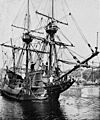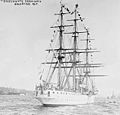Hudson–Fulton Celebration facts for kids
The Hudson–Fulton Celebration was a huge party held in New York and New Jersey. It took place from September 25 to October 9, 1909. This event celebrated two important anniversaries.
First, it marked 300 years since Henry Hudson explored the Hudson River. Second, it celebrated 100 years since Robert Fulton successfully used his paddle steamer for business. These two men showed how important the river would become for New York. The celebration also showed how important New York City was becoming in the world.
Contents
Bright Lights and Fireworks
Electricity was a big part of the celebration. Ships and monuments were lit up for two weeks. On September 25, the naval fleet was illuminated. Then, fireworks lit up the night sky over the Hudson River. These fireworks were launched from the Jersey Shore. This way, everyone could see them from Riverside Park.
The organizers spent a lot of money on lights and fireworks. They used 107,152 lights for the event. This included 500,000 new light bulbs just for the celebration! Many famous landmarks were lit up. These included the Statue of Liberty, Grant's Tomb, and the Washington Square Arch. Searchlights also shone on Grant's Tomb and the Statue of Liberty. The city glowed with excitement.
Exciting Parades
Two big parades took place during the celebration. They were held between September 25 and October 9, 1909. The Historical Parade taught people about New York's past. The Carnival Parade showed off the city's culture.
The Historical Parade
The Historical Parade had 54 floats. They were divided into four main parts, showing different times in New York's history. These were the Indian Period, the Dutch Period, the English or Colonial Period, and the American or Modern Period. A giant float led the parade. It showed "The History of the Empire State." This float featured a canoe, a steamboat, a wigwam, and even the Statue of Liberty. It showed how much New York had changed over time.
The Carnival Parade
The Carnival Parade happened later, on the evening of October 2, 1909. It followed the same route as the Historical Parade. This parade showed stories from old world folklore. These stories inspired much of the art, music, and poetry around the world.
A huge dragon float led the Carnival Parade. It breathed flames and carried a scroll. The scroll announced the parade's theme: "Music, Literature, and Art." Forty-nine floats followed, showing different ideas. Some floats showed "colors," "peace," and "song." Others showed scenes like "The Crowning of Beethoven." There were also floats about mythology and fairy tales. You could see floats for the Queen of Sheba, Medusa, and Cinderella. The last float showed "Uncle Sam Welcoming the Nations." This float showed America's friendly spirit.
Both parades were very popular. People in New York loved watching the spectacle. The organizers did a great job of entertaining everyone.
Ships and Airplanes
The celebration honored Hudson and Fulton by recreating their famous vessels. Replicas of Hudson's Half Moon and Fulton's Clermont were built. These ships were shown off with great excitement. They joined a large parade of American and foreign warships. This parade showed the strength of the United States Navy.
The celebration also displayed new ways of travel. The famous RMS Lusitania was shown. It was a very advanced steamship for its time. Sadly, it was sunk by a German U-boat in 1915.

The celebration also featured public flights by Wilbur Wright. He was famous for his flights in Europe. On September 29, he flew around the Statue of Liberty. On October 4, he flew for 33 minutes over the Hudson River. He flew to Grant's Tomb and back. About a million New Yorkers saw their first airplane flight that day!
New York City's Story
The celebration also focused on the history of New York City and State. It showed how New York grew from Native American communities to a big city in 1909. The Historical Parade showed this story. It covered the Native American, Dutch, English, and American periods.
The Dutch part of the parade was very important. At that time, many people admired Dutch contributions to New York. This was part of a movement called "Holland Mania." It highlighted Dutch values like religious tolerance and good education.
Education was a key goal of the celebration. The Historical Parade helped teach new immigrants about U.S. and New York history. Many children of immigrant families were encouraged to learn. Leaders believed that educating children was important for New York's future. Children had a special role in the celebration. Hundreds of thousands took part in a Children's Festival. It included kids from all backgrounds, even African Americans. The festival had dances, patriotic displays, and history lessons.
Celebrating New York's Culture
The Carnival Parade showed New York's growing culture. It displayed music, art, and literature from the "Old World." This helped connect New York to big European cities like London and Paris. This night parade lit up New York, creating a fun and exciting atmosphere.
The celebration showed New York as a global city. Many museum exhibitions were created for the event. They attracted tourists from Europe and other parts of the United States. People watched the parades on Fifth Avenue in awe. They bought postcards to remember their visit. Postcards were a popular hobby and helped the postal service.
The Hudson–Fulton Celebration was more than just remembering two men. It was a way to show New York's history and culture. It also highlighted social changes happening at the time. The event helped make New York famous around the world. Millions of people enjoyed this grand celebration in 1909. It is still a success worth remembering today. A special plate was even made to celebrate the event. It showed Wilbur Wright flying over the Hudson River.
Images for kids











